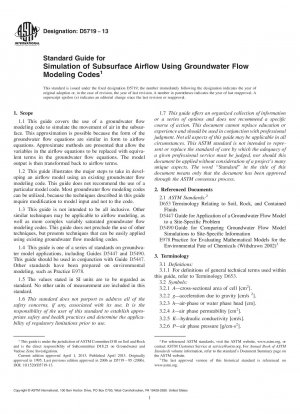ASTM D5719-13
Standard Guide for Simulation of Subsurface Airflow Using Groundwater Flow Modeling Codes
- Standard No.
- ASTM D5719-13
- Release Date
- 2013
- Published By
- American Society for Testing and Materials (ASTM)
- Latest
- ASTM D5719-13
- Scope
5.1 The use of vapor extraction systems (VES), also called soil vapor extraction (SVE) or venting systems, is becoming a common remedial technology applicable to sites contaminated with volatile compounds (3, 4). A vapor extraction system is composed of wells or trenches screened within the vadose zone. Air is extracted from these wells to remove organic compounds that readily partition between solid or liquid phases into the gas phase. The volatile contaminants are removed in the gas phase and treated or discharged to the atmosphere. In many cases, the vapor extraction system also incorporates wells open to the atmosphere that act as air injection wells.
Note 1—Few model codes are available that allow simulation of the movement of air, water, and nonaqueous liquids through the subsurface. Those model codes that are available (5, 6), require inordinate compute hardware, are complicated to use, and require collection of field data that may be difficult or expensive to obtain. In the future, as computer capabilities expand, this may not be a significant problem. Today, however, these complex models are not applied routinely to the design of vapor extraction systems.5.2 This guide presents approximate methods to efficiently simulate the movement of air through the vadose zone. These methods neglect the presence of water and other liquids in the vadose zone; however, these techniques are much easier to apply and require significantly less computer hardware than more robust numerical models.
5.3 This guide should be used by groundwater modelers to approximately simulate the movement of air in the vadose zone.
5.4 Use of this guide to simulate subsurface air movement does not guarantee that the airflow model is valid. This guide simply describes mathematical techniques for simulating subsurface air movement with groundwater modeling codes. As with any modeling study, the modeler must have a thorough understanding of site conditions with supporting data in order to properly apply the techniques presented in this guide.
1.1 This guide covers the use of a groundwater flow modeling code to simulate the movement of air in the subsurface. This approximation is possible because the form of the groundwater flow equations are similar in form to airflow equations. Approximate methods are presented that allow the variables in the airflow equations to be replaced with equivalent terms in the groundwater flow equations. The model output is then transformed back to airflow terms.
1.2 This guide illustrates the major steps to take in developing an airflow model using an existing groundwater flow modeling code. This guide does not recommend the use of a particular model code. Most groundwater flow modeling codes can be utilized, because the techniques described in this guide require modification to model input and not to the code.
1.3 This guide is not intended to be all inclusive. Other similar technique......
ASTM D5719-13 Referenced Document
- ASTM D5447 Standard Guide for Application of a Numerical Groundwater Flow Model to a Site-Specific Problem
- ASTM D5490 Standard Guide for Comparing Ground-Water Flow Model Simulations to Site-Specific Information
- ASTM D653 Standard Terminology Relating to Soil, Rock, and Contained Fluids
- ASTM E978
ASTM D5719-13 history
- 2013 ASTM D5719-13 Standard Guide for Simulation of Subsurface Airflow Using Groundwater Flow Modeling Codes
- 1995 ASTM D5719-95(2006) Standard Guide for Simulation of Subsurface Airflow Using Ground-Water Flow Modeling Codes
- 1995 ASTM D5719-95(2000) Standard Guide for Simulation of Subsurface Airflow Using Ground-Water Flow Modeling Codes

Copyright ©2024 All Rights Reserved